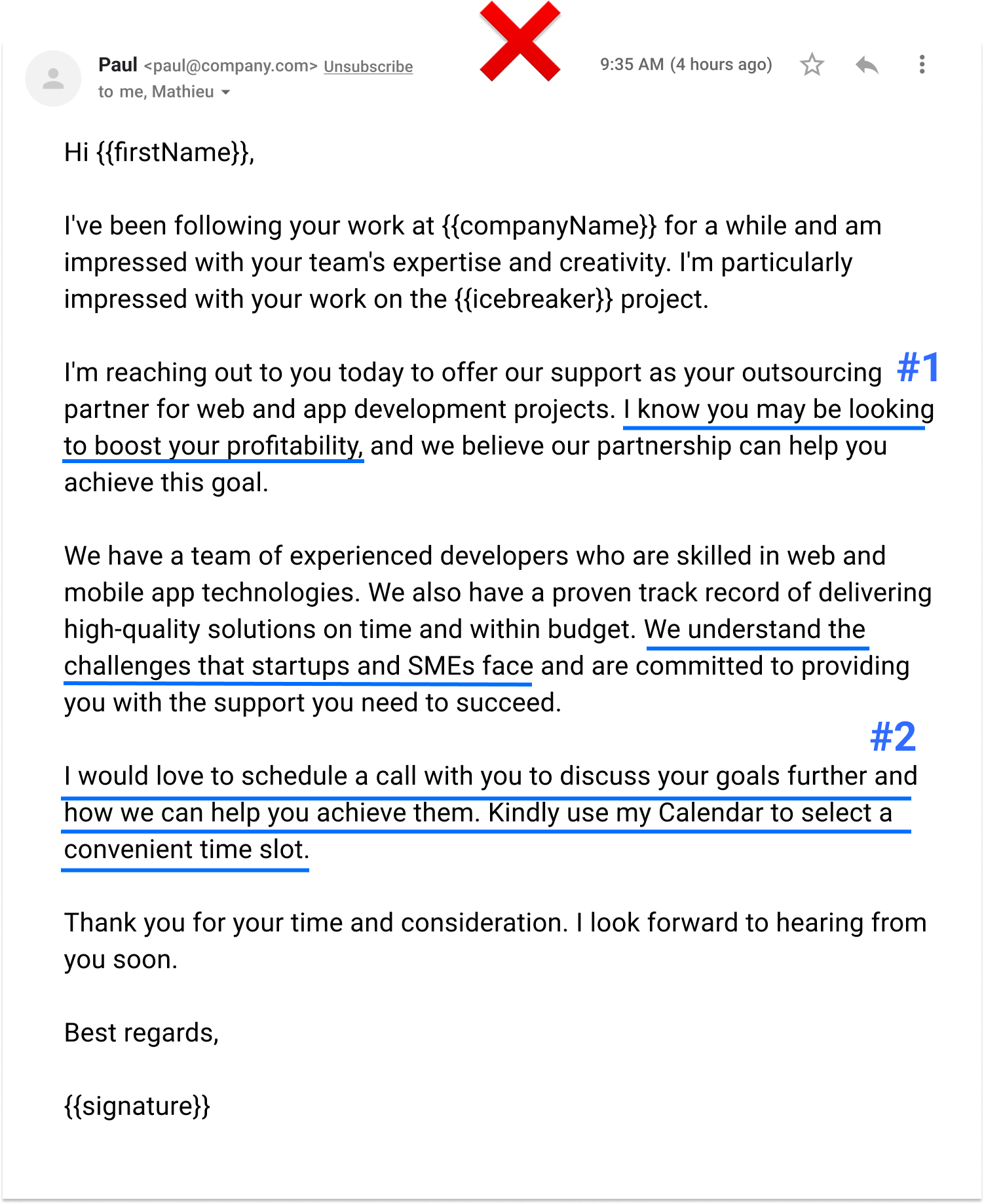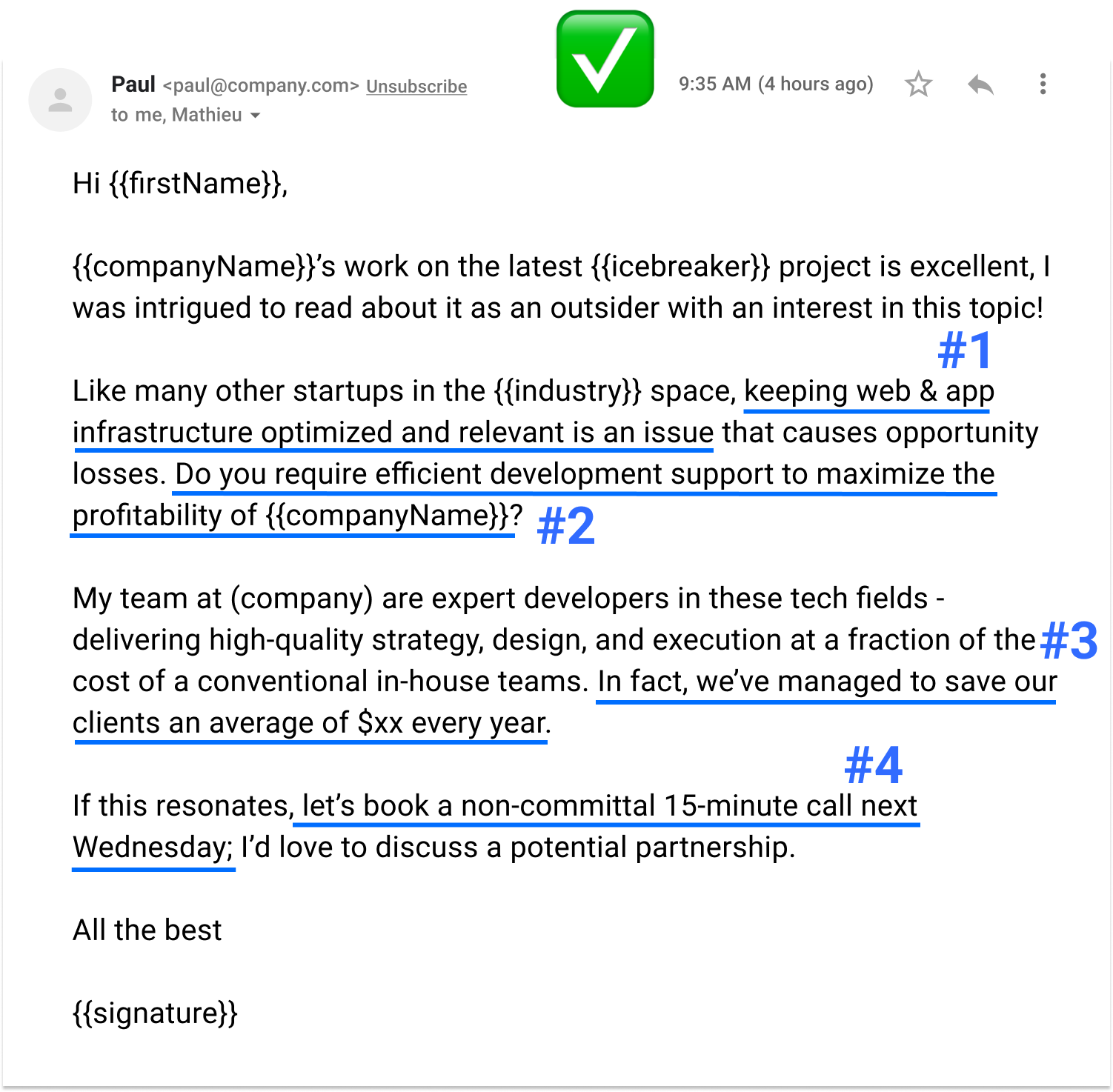As a web or app developer, you may find yourself fighting for your target’s attention in an email inbox full of similar pitches. Not to mention convincing companies that outsourcing is the quickest and most effective way to go.
Vague pain points and long paragraphs aren’t the solution.
So, how do you structure a cold email that stands out and leads to more conversions?
Check out how Mathieu Larocque, the Head of Email Marketing at Cactus Marketing, tears down a cold email and improves it for more replies.
Cold email mistakes to avoid if you want to book more meetings
Here’s a cold email that aims to help digital agencies outsource their web and app development needs

Here’s what stops prospects from replying to this cold email:
Mistake #1: Generic pain points
If you want to stick out from other generic cold emails, ensure to point out pain points specific to your lead. This shows you did a proper research and your solution is relevant.
Mistake #2: No strong enough CTA
If you want your leads to take a desired action, you have to give them a strong reason with a clear next step. Otherwise, they might get lost in too long explanation and end up doing nothing.
Mistake #3: No relevance
Without letting your prospects know why this email is for them, you aren’t giving them a reason to take action and book a call with you. Instead, mention why your message is relevant specifically for them.
Mistake #4: Too long email length
Instead of long paragraphs, ensure to use 3-7 sentence structure. Because a majority of people scan cold emails, this helps them to see the value right off the bat.
How to write a cold email for a high conversion rate
Here’s how Mathieu would rewrite this cold email for higher reply chances:

What tips can you replicate from this email for more replies?
Tip #1: Validate relevance with a question
Use your first cold email to confirm the interest and validate your prospects’ relevance by asking a simple question.
Tip #2: Tackles a challenge
When you know your leads’ pain point, make sure to emphasize it to make them aware of their need for your solution.
Tip #3: Add metrics as social proof
Add relevant metrics that are aligned with your leads’ desired outcomes. This helps you boost credibility and trust, and makes them more likely to engage.
Tip #4: Use clear CTA
Use a clear timeline for booking a call with your prospect to remove the friction and make it super easy for them to take the next step.
Cold email template to replicate for more replies
Hi {{firstName}},
{{companyName}}’s work on the latest {{icebreaker}} project is excellent, I was intrigued to read about it as an outsider with an interest in this topic!
Like many other startups in the {{industry}} space, keeping web & app infrastructure optimized and relevant is an issue that causes opportunity losses. Do you require efficient development support to maximize the profitability of {{companyName}}?
My team at (company) are expert developers in these tech fields – delivering high-quality strategy, design, and execution at a fraction of the cost of a conventional in-house team. In fact, we’ve managed to save our clients an average of $xx every year.
If this resonates, let’s book a non-committal 15-minute call next Wednesday; I’d love to discuss a potential partnership.
All the best
{{signature}}
The key takeaways
Here are Mathieu’s tips you can implement today and grow your business with cold outreach:
-> Address specific pain points unique to your lead
-> Ensure your CTA is clear and compelling
-> Add relevant metrics to build credibility and trust
-> Keep the email concise, typically 3-7 sentences
You can watch Mathieu’s full cold email teardown here!
PS: Want more tips? Request outbound experts to review your cold emails here.
Your source of actionable outreach tips and strategies that will help you get replies and grow your business.

